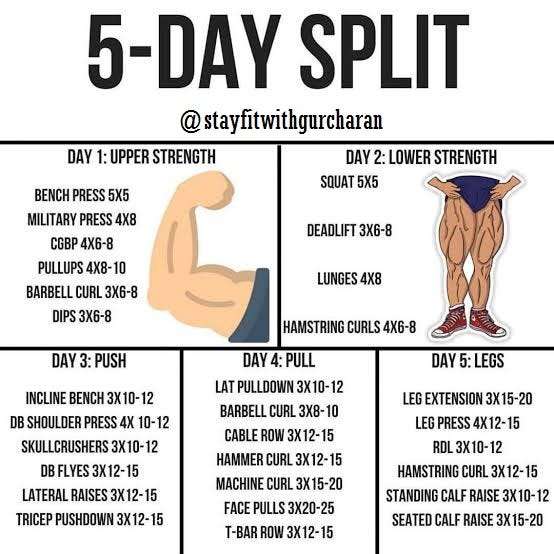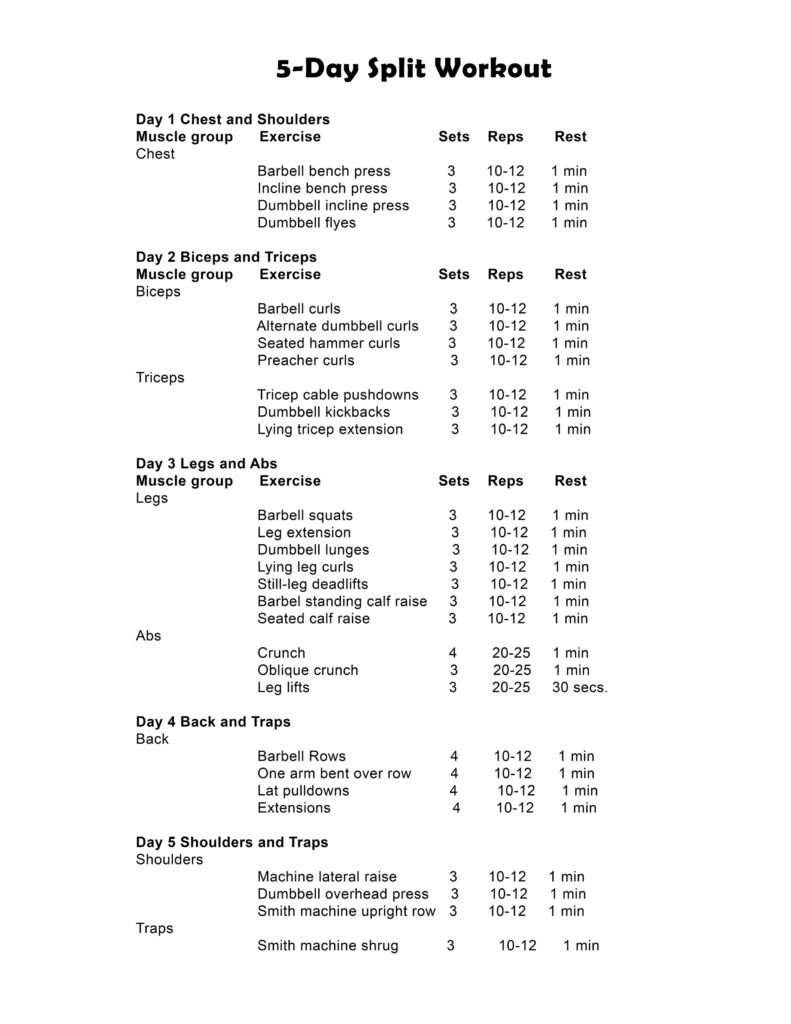So, you’ve decided to kickstart your fitness journey and want to know the best way to structure your workouts for maximum gains. Well, look no further! In this article, we’ll be breaking down the recommended muscle group workout split for a 5-day routine. Whether you’re a beginner or a seasoned gym-goer, this guide will provide you with valuable insights on how to effectively target different muscle groups throughout the week. So grab your workout gear and get ready to take your fitness game to the next level!
1. The Importance of Muscle Group Workout Splits
1.1 Understanding Muscle Group Workout Splits
When it comes to designing an effective workout routine, one important factor to consider is muscle group workout splits. But what exactly does this mean? Well, a muscle group workout split refers to the way you divide your training sessions to target specific muscle groups on different days of the week. Instead of working your entire body in every workout, you focus on specific muscle groups during each session.
1.2 Benefits of Muscle Group Workout Splits
Now you might be wondering, what’s the point of dividing your workouts based on muscle groups? Well, there are several benefits to incorporating muscle group workout splits into your routine.
Firstly, it allows you to focus and prioritize certain muscle groups. By dedicating specific days to target different areas, you can give each muscle group the attention it needs to grow and develop. This targeted approach helps to ensure that you are working each muscle group to its full potential.
Secondly, muscle group workout splits provide ample time for recovery. When you work out, you are essentially breaking down your muscles. It is during rest and recovery that these muscles repair and grow stronger. By splitting your workouts, you give your muscles enough time to rest and recover before you target them again. This helps to prevent overtraining and reduces the risk of injury.
Thirdly, muscle group workout splits allow for more focused and efficient training. Instead of spending endless hours at the gym trying to work every muscle group in a single session, you can devote specific days to each group. This allows you to perform more exercises and sets for each muscle group, leading to greater muscle activation and overall progress.

2. Different Approaches to Muscle Group Workout Splits
2.1 Whole Body Workout Split
The whole-body workout split is perhaps the most basic and straightforward approach. As the name suggests, it involves training your entire body during each workout session. This approach is suitable for beginners or those with limited time to devote to the gym. It allows you to work all major muscle groups in a single session, typically performed two to three times a week.
2.2 Push-Pull Workout Split
The push-pull workout split divides your training sessions into two main categories: push exercises and pull exercises. Push exercises primarily target muscles involved in pushing movements, such as chest, shoulders, and triceps. Pull exercises, on the other hand, focus on muscles used in pulling movements, such as back and biceps. This split allows you to separate muscle groups based on their primary function.
2.3 Upper-Lower Body Workout Split
The upper-lower body workout split divides your training sessions into upper body and lower body workouts. This split is great for those who want to focus on building strength and size in both their upper and lower body. It allows you to perform more exercises and sets for each area, ensuring balanced development.
2.4 Body Part Workout Split
The body part workout split is a more advanced approach that targets specific muscle groups on different days of the week. For example, you might dedicate one day to train your chest, another day for back, and so on. This split is popular among bodybuilders who want to focus on individual muscle groups to achieve maximum hypertrophy and definition.

3. Recommended Muscle Group Workout Split for a 5-Day Routine
3.1 Day 1: Upper Body Push
On the first day of your 5-day routine, focus on pushing movements for the upper body. This includes exercises such as bench presses, shoulder presses, and tricep dips. By targeting the chest, shoulders, and triceps, you can build strength and size in these muscle groups.
3.2 Day 2: Lower Body
Dedicate the second day to training your lower body. Perform exercises like squats, lunges, and deadlifts to target your quads, hamstrings, glutes, and calves. Training the lower body is crucial for overall strength and athleticism.
3.3 Day 3: Upper Body Pull
On the third day, shift your focus to pulling movements for the upper body. This includes exercises like pull-ups, rows, and bicep curls. By targeting the back and biceps, you can develop a strong and well-defined upper body.
3.4 Day 4: Full Body Compound Movements
Use the fourth day to incorporate full body compound movements. These exercises engage multiple muscle groups simultaneously and are highly effective for building overall strength and conditioning. Some examples of compound exercises include squats, deadlifts, bench presses, and overhead presses.
3.5 Day 5: Body Part Focus
Finish your 5-day routine by targeting a specific body part you want to give extra attention to. This could be your abs, arms, or any other muscle group that you feel needs additional work.

4. Considerations for Choosing the Right Muscle Group Workout Split
4.1 Individual Goals and Preferences
When choosing a muscle group workout split, it’s important to consider your individual goals and preferences. If you’re looking to build overall strength and size, a whole-body or upper-lower body split may be suitable. On the other hand, if you have specific muscle groups you want to prioritize or are aiming for bodybuilding-level aesthetics, a body part split may be more appropriate.
4.2 Training Experience and Ability
Your training experience and ability should also influence your choice of workout split. Beginners may benefit from starting with a whole-body or push-pull split to build a solid foundation of strength and technique. As you become more experienced, you can progress to more advanced splits that allow for greater muscle isolation and specialization.
4.3 Recovery and Rest Days
Another crucial consideration is recovery and rest days. Ensure that your chosen workout split allows for adequate rest and recovery between training sessions. This will prevent overtraining and optimize muscle growth. Listen to your body and adjust your split if needed to ensure you are giving your muscles enough time to recover.

5. Optimizing Your Muscle Group Workout Split
5.1 Warm-Up and Cool-Down
Regardless of the muscle group workout split you choose, it’s essential to incorporate warm-up and cool-down exercises into each session. Warming up prepares your muscles for the upcoming workout and reduces the risk of injury. Cooling down helps with muscle recovery and prevents post-workout stiffness. Include dynamic stretches and light cardio exercises as part of your warm-up and static stretches for your cool-down.
5.2 Proper Exercise Selection
Selecting the right exercises for each muscle group is crucial to your overall progress. Focus on compound exercises that target multiple muscle groups for maximum efficiency. However, don’t neglect isolation exercises that specifically target individual muscles for detailed development. Balance is key when it comes to exercise selection.
5.3 Progressive Overload
To continue making progress, it’s important to incorporate progressive overload into your workouts. This involves gradually increasing the intensity, volume, or difficulty of your exercises over time. Whether it’s adding more weight, increasing repetitions, or shortening rest periods, constantly challenge your muscles to adapt and grow.
5.4 Balanced Muscle Development
While it can be tempting to focus only on your favorite muscle groups, it’s essential to prioritize balanced muscle development. Neglecting certain muscle groups can lead to imbalances, which can affect your posture, strength, and overall performance. Ensure that your chosen workout split includes exercises that target all major muscle groups for a well-rounded physique.
5.5 Tracking and Monitoring Progress
Keep track of your workouts and monitor your progress to ensure that you are making gains and reaching your goals. This can be done through a workout journal, a fitness app, or simply taking notes of the exercises, sets, and reps you perform. Regularly reassess your workout split to make adjustments based on your progress and adapt to any changing goals or needs.
In conclusion, a muscle group workout split is an effective way to structure your training routine to target specific muscle groups. By understanding the different approaches to muscle group workout splits and considering your goals, preferences, and recovery needs, you can choose the right split for you. Remember to optimize your split with warm-ups, proper exercise selection, progressive overload, balanced muscle development, and tracking your progress. With the right muscle group workout split and dedication, you can take your fitness journey to new heights.

